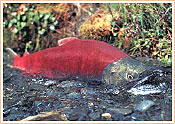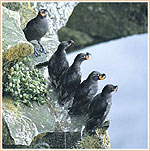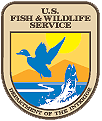 National Wildlife Refuge System
National Wildlife Refuge SystemA Visitor's Guide
 National Wildlife Refuge System
National Wildlife Refuge System
A Visitor's Guide
U.S. Fish & Wildlife Service
PDF Version
Welcome to Your National Wildlife Refuge System
I am pleased that you are visiting one of our National Wildlife Refuges. The National Wildlife Refuge System provides the opportunity to see an eagle soar, watch a buffalo roam, or fish in a pristine stream. The magnificence of the great outdoors offers treasured experiences and memories.
There are more than 500 National Wildlife Refuges throughout the United States. There is at least one refuge within an hour’s drive of most major cities. At a refuge, you can learn about our environment, take a friend hunting or fishing, or snap pictures of wildlife. I am proud to be one of nearly 40 million Americans who visit National Wildlife Refuges each year. During your visit, I hope you enjoy the best of wild America.
Gale Norton
Secretary of the Interior
 Why Wildlife Refuges?
Why Wildlife Refuges?
The National Wildlife Refuge System is the only network of federal lands dedicated specifically to wildlife conservation. Home to more than 700 types of birds, 220 different mammals, 250 reptiles, and more than 200 kinds of fish, the amazing variety of wildlife found on refuges reflects America’s bountiful natural heritage. Many wildlife refuges were created to protect and enhance the resting and feeding grounds of migratory birds, creating a chain of stepping stones along major migration routes. Others were established to conserve the natural homes of our rarest wild species, including bald eagles, bison, and whooping cranes.
Watch wildlife from a distance. When you approach a wild animal, it may defend itself, or flee but from a distance you can see its natural behavior.
 In southern wildlife refuges, peaceful coastal
backwaters and bayous provide important
spawning areas for fish. Countless shallow ponds
and marshes in the Upper Midwest, created
thousands of years ago by receding glaciers, are
now prairie “pothole” refuges, critical for
waterfowl as well as wildflowers. In the Northeast,
a variety of unique wetlands and forests provide
havens for songbirds, waterfowl, whitetail deer,
and a multitude of small game. The rich grasslands
and mountain streams of western wildlife refuges
offer magnificent scenery for viewing elk, cutthroat
trout, and sandhill cranes. Alaska refuges’ vast
horizons are home to more than 12 million ducks,
geese, and swans each summer, and host the most
vibrant salmon runs, the world’s largest brown
bears, and magnificent herds of caribou.
In southern wildlife refuges, peaceful coastal
backwaters and bayous provide important
spawning areas for fish. Countless shallow ponds
and marshes in the Upper Midwest, created
thousands of years ago by receding glaciers, are
now prairie “pothole” refuges, critical for
waterfowl as well as wildflowers. In the Northeast,
a variety of unique wetlands and forests provide
havens for songbirds, waterfowl, whitetail deer,
and a multitude of small game. The rich grasslands
and mountain streams of western wildlife refuges
offer magnificent scenery for viewing elk, cutthroat
trout, and sandhill cranes. Alaska refuges’ vast
horizons are home to more than 12 million ducks,
geese, and swans each summer, and host the most
vibrant salmon runs, the world’s largest brown
bears, and magnificent herds of caribou.
A hundred years in the making, the National Wildlife Refuge System is a network of carefully chosen habitats that support abundant wildlife, protect a healthy environment, and provide unparalleled outdoor experiences for all Americans.
America’s Best Kept Secret
National wildlife refuges are far more than havens for wild plants and animals. In fact, visitors—nearly 40 million each year—are welcome on 98 percent of wildlife refuge land. Visitors join in a variety of outdoor activities, especially hunting, fishing, wildlife observation, photography, interpretation, and environmental education.
Wildlife refuges host recreational hunters at more than 300 locations and welcome anglers at more than 260—a testament to the abundant wildlife resulting from successful conservation and management programs. Birdwatchers from around the globe visit wildlife refuges to be awed by amazing congregations of our feathered friends, numbering in the tens of thousands at peak migration in many locations. And there’s no better place than wildlife refuges for children and adults alike to learn about the natural world. More than 230 wildlife refuges attract visitors with innovative educational programs showing how we manage refuges to ensure that future generations can experience America’s wildness. Still, the discovery opportunities don’t end with wildlife. Wildlife refuges also protect important historic sites, from Native American campsites to World War II artifacts, preserving interesting facets of the American culture.
Caring for Wildlife and Their Surroundings
 For millennia, America’s wildlife thrived in natural
surroundings stretching across millions of acres.
Areas that in recent times have been reduced to
a fraction of their original size—but are still crucial
to the survival of wild species—require active,
consistent, research-based management. The
National Wildlife Refuge System oversees the
world’s most comprehensive wildlife management
programs, combining biological research and
monitoring with strategic habitat management.
In Alaska for example, brown bears are fitted with
global positioning system collars to track their
movement. We build secure floating nests on the
California coast to attract and protect rare lightfooted
clapper rails during breeding and
nesting season. Periodic burning,
grazing, or harvesting of grasslands
stimulates plant growth providing
food and cover for elk, endangered
Attwater prairie chickens, and
waterfowl alike.
For millennia, America’s wildlife thrived in natural
surroundings stretching across millions of acres.
Areas that in recent times have been reduced to
a fraction of their original size—but are still crucial
to the survival of wild species—require active,
consistent, research-based management. The
National Wildlife Refuge System oversees the
world’s most comprehensive wildlife management
programs, combining biological research and
monitoring with strategic habitat management.
In Alaska for example, brown bears are fitted with
global positioning system collars to track their
movement. We build secure floating nests on the
California coast to attract and protect rare lightfooted
clapper rails during breeding and
nesting season. Periodic burning,
grazing, or harvesting of grasslands
stimulates plant growth providing
food and cover for elk, endangered
Attwater prairie chickens, and
waterfowl alike.
Wake up with the birds. Arrive in the early morning (or late afternoon) when wildlife is most active.
 Sometimes the
best management
is doing nothing at
all. Within the
National Wildlife
Refuge System,
21 million acres
of wilderness—
an area larger
than the states of Rhode Island, Connecticut,
Delaware, Hawaii, Massachusetts, and New Jersey
combined—allow species as diverse as Florida
panthers and barren-ground caribou to survive in
undisturbed surroundings.
Sometimes the
best management
is doing nothing at
all. Within the
National Wildlife
Refuge System,
21 million acres
of wilderness—
an area larger
than the states of Rhode Island, Connecticut,
Delaware, Hawaii, Massachusetts, and New Jersey
combined—allow species as diverse as Florida
panthers and barren-ground caribou to survive in
undisturbed surroundings.
Contact the wildlife refuge before you visit for up-to-date information on access, special activities, weather conditions, and more.
From the Smallest Beginning . . .
 President Theodore Roosevelt
established the first wildlife refuge in
1903, Florida’s 3-acre Pelican Island, to
protect egrets, herons, and other
birds from market hunters who
killed these birds by the thousands
to satisfy turn-of-the-century
fashion demands. From this humble
beginning, Americans have embraced the concept of
providing unique places for wildlife to flourish, while
also allowing for many forms of wildlife dependent
recreation. Through cooperative efforts with a growing
number of partners and committed citizens, the
National Wildlife Refuge System has become a model
of stewardship where all Americans and International
visitors can enjoy our precious natural resources.
President Theodore Roosevelt
established the first wildlife refuge in
1903, Florida’s 3-acre Pelican Island, to
protect egrets, herons, and other
birds from market hunters who
killed these birds by the thousands
to satisfy turn-of-the-century
fashion demands. From this humble
beginning, Americans have embraced the concept of
providing unique places for wildlife to flourish, while
also allowing for many forms of wildlife dependent
recreation. Through cooperative efforts with a growing
number of partners and committed citizens, the
National Wildlife Refuge System has become a model
of stewardship where all Americans and International
visitors can enjoy our precious natural resources.
As you spend time learning about the National Wildlife Refuge System, take a moment to thank the millions of volunteers, hunters, anglers, and other conservationists that help us continue America’s wildlife heritage. Enjoy your visit!
Steven A. Williams
Director, U.S. Fish and Wildlife Service
U.S. Department of the Interior
U.S. Fish & Wildlife Service
Visit us online at www.fws.gov/refuges
There is at least one refuge within an hour’s drive from every major American city.
“To administer a national network of lands and waters for the conservation, management, and where appropriate, restoration of the fish, wildlife, and plant resources and their habitats within the United States for the benefit of present and future generations of Americans.”
For additional copies of this guide, please contact any Service office listed below; or call 1 800/344 WILD:
 USFWS—Pacific Region
USFWS—Pacific Region
911 NE 11th Avenue, Eastside Federal Complex
Portland, OR 97232-4181
(CA, ID, HI, NV, OR, WA)
USFWS—Southwest Region
P.O. Box 1306
Albuquerque, NM 87103
(AZ, NM, OK, TX)
 USFWS—Great Lakes-Big Rivers Region
USFWS—Great Lakes-Big Rivers Region
1 Federal Drive, Federal Building
Fort Snelling, MN 55111-4056
(IL, IN, IA, MI, MN, MO, OH, WI)
USFWS—Southeast Region
1875 Century Blvd.
Atlanta, GA 30345-3203
(AR, AL, FL, GA, KY, LA, MS, NC, SC, TN, PR)
USFWS—Northeast Region
300 Westgate Center Drive
Hadley, MA 01035-9589
(CT, DE, ME, MD, MA, NH, NJ, NY, PA, RI, VT, VA, WV)
 USFWS—Mountain Prairie-Region
USFWS—Mountain Prairie-Region
Box 25486, Denver Federal Center
Denver, CO 80225
(CO, KS, MT, NE, ND, SD, UT, WY)
USFWS—Alaska Region
1011 East Tudor Road
Anchorage, AK 99503
(AK)
USFWS—Publications Unit
National Conservation Training Center
Route 1, Box 166, Shepherd Grade Road
Shepherdstown, WV 25443
 |
 |
 |